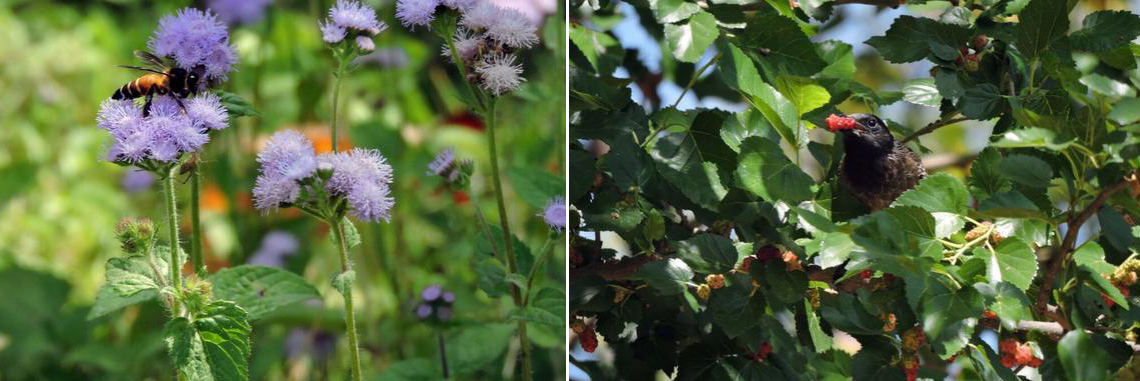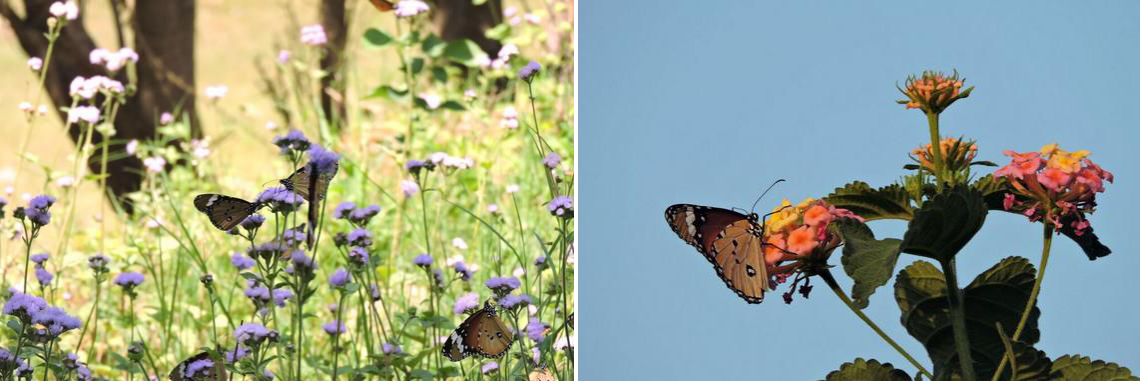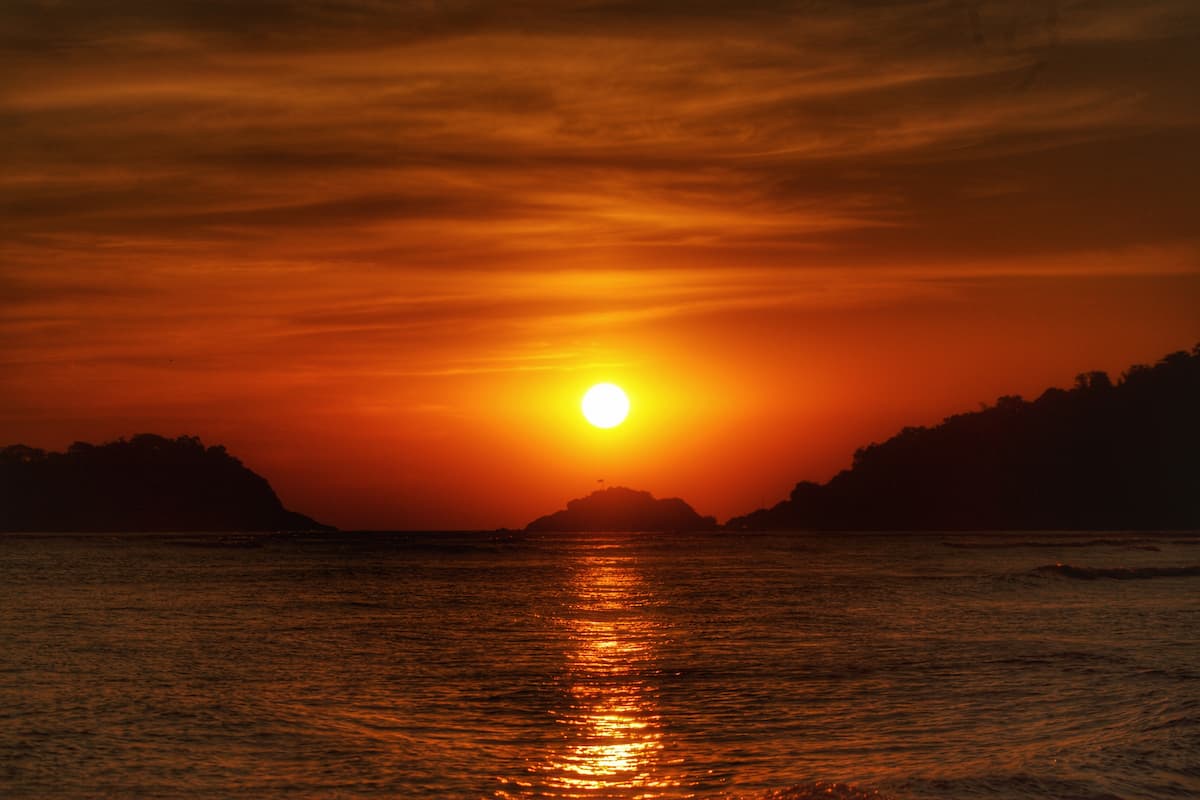Sparkling Lakes – Nainital, Part V
Did you know that Steve Jobs and Julia Roberts have stayed at Neem Karauli Baba’s ashram Kainchi, 17 km from Nainital ? In the final part, traveler Shireen Bharucha describes the magnificent British architecture of the heritage sites in Nainital and her tryst with sumptuous Kumaoni delicacies.
Located 22 km from Nainital, Bhimtal is encircled by the Kumaoun hills. Named after Bhima of Mahabharata fame, it is a perennial lake and the biggest in Nainital district. Forests of oak and pine cover the hill slopes around the lake. Though not as spectacular as Naukuchiatal, it is more entertaining. A unique feature of this lake is a small island in the middle which houses an aquarium. The aquarium can be reached by boat. Terraced gardens by the walkway add to the ambience. Some geese and ducks swim elegantly, while others flap their wings vigorously and a few diving headlong into the lake, make for an engaging sight. Boating and fishing are added attractions.

Our tour of lakes ends at Sat Tal (seven lakes). Here seven fresh water lakes, namely Garud Tal, Nal-Damyanti Tal, Purna Tal, Sita Tal, Ram Tal, Laxman Tal and Sukha Tal are interconnected. Set amongst dense forests, the site is unspoiled and unpolluted, as no construction is allowed since the land belongs to the forest department, Rakesh informs us. In spite of this, there are several food stalls and two Kashmiri Emporiums! Little wonder then, that this site attracts a lot of sightseers. Rakesh recommends lunch at Gitanjali, well known for its curry rice and rajma rice. We order a dish of rajma (red kidney beans) and paneermuttar (cottage cheese and peas), that go well with fluffy light chapattis. The food is good and prices are reasonable. On the shore of the lake a gaggle of geese honks noisily, while a yellow wagtail, observes the scene. After lunch we stroll along the pathway. A delicate curtain of orange flowers on spindly branches, probably of the weeping willow, hangs over the glittering, grey-green, gently rippling lake, through which we discern a meadow with cattle grazing. Besides boating, adventure sports are encouraged.
Our final destination for the day is Neem Karauli Baba’s ashram at Kainchi, 17 km from Nainital – a complex of simple structures, amid a small but artistically laid out garden through which a mountain stream cascades. Among others, the Baba was a guru to a number of American hippies who came to India in the 1960s and 70s, one of whom was Apple founder, Steve Jobs. According to Steve Woznaik, a college friend of Steve Jobs, it was Job’s stay in India that inspired him to found Apple. Jobs came to India in mid-1974 to visit the Baba, but the guru had passed away in September 1973. Jobs stayed on at the ashram and learnt about the Baba’s teachings. A more recent disciple is Hollywood actress Julia Roberts. The ashram is well maintained. There is not much within the ashram – Baba’s photos hang on the walls, and the cot he slept on is displayed. A statue of Baba is in a marble enclosure. The ashram is now a pilgrimage centre and during the temple fair held on the 15th of June each year, one lakh devotees are fed. Baba also built a Hanuman temple close to the ashram. There is a cave beside the temple where Baba used to pray, which is considered sacred.
Our last day is devoted to two heritage sites, the first being Raj Bhavan, the official residence of the Governor of Uttarakhand. This awe inspiring, magnificently designed Victorian Gothic edifice is double storied. The construction commenced on 27 April 1897 and was completed in March 1900. This is one of the few Raj Bhavans in the country, where select rooms on the ground floor of the total 113 rooms, are open for public viewing. The estate sprawls over 220 acres. There is a guided tour daily from 11 a.m. to 12 p.m. on the premises, which we join. There are no tours on Sundays, public holidays or when the Governor is in residence. The entry fee is Rs.50/- per head.
The tour starts with a short walk through the 160 acres of forest lush with deodar and oak trees, till we come to the entrance. As we enter the lobby, an enormous and ornate fireplace welcomes us. The guide informs us that the show pieces on its mantle are exactly as the British left them, as is the large dinner gong that hangs from a gigantic pair of elephant tusks. During colonial times, this was the Governor’s residence.
Burma teak is used for the main stairway, the paneling of the dining room, which the guide tells us can seat 75 diners at a time, all the doors and windows and some of the principal floors. For less important floors, shisham (rose wood), satin wood, cypress and sal have been used. The glass, tiles, brass fittings and iron pipes were imported from England. Masons from Agra executed the ‘ashlar’ stone work. Ashlar masons build walls, arches and buildings through correct placement of varied sizes of rectangular stone blocks. Carpenters from Punjab were employed for the wood work. The furniture was procured from England and Calcutta (today Kolkata). All the furniture, wooden and metal, intricately carved, is the original furniture used by the British, only the tapestry has been changed. The construction of the building allows for a maximum of natural light.
Candle chandeliers adorn the ceilings of all rooms. The walls show off deer heads and antlers as also weapons that were seized from the infamous Sultana Daku – lances, swords, muzzle loaders and knives. We are led into the ballroom which exudes elegance and old world charm, with the orchestra gallery above. Springs have been put under the flooring of the ball room to make dancing easy on the feet. The recreation room and the breakfast room have metal furniture and ceilings of glass panes. While the panes of the recreation room are broken, the ones in the breakfast room are intact. The glass panes are supported by a wire meshing underneath. We are also shown the waiting room for the governor’s guests – the only room that has been refurbished.
Paths through manicured lawns take us down to the golf course set against a verdant backdrop. The 18-hole golf course has 18 different tees. The golf course designed by British Army engineers spreads over 50 acres. Golfing started in 1926. The golf course is one of the best in the country and hosts many golf championships. It is open to the public for a fee. Visitors can also use the club house and the restaurant attached to it.
We exit the golf course through a forested path where wild flowers grow, bees buzz and butterflies float till we reach the green roofed secretariat where the governor’s staff works when the governor is in residence. This is the end of the tour.

Bee on Floss Flower | Bulbul with mulberry

Butterflies on blue floss flowers | Butterfly on Lantana
We arrive at the second site through a slip-up, rather than by design. We are keen to see Nainital born, Jim Corbett, the distinguished hunter, conservationist and writer’s one time residence – Gurney House. We ask a staffer at Sterling for directions. He politely assures us that Jim Corbett’s house is not in Nainital, but in Kaladhungi, 34 km away and directs us there. Kaladhungi was the winter residence of the Corbetts, which has been converted into a museum as a memorial to Jim Corbett. The entry fee is Rs.10/- per head. The well maintained, green roofed rustic cottage, with its arched doorways sports a bust of Jim Corbett at the entrance. The interiors exhibit Corbett’s personal belongings: furniture, crockery, fishing net, gun, cap, family photographs, huge oil paintings of Corbett and letters. The garden is pleasant – some langurs make merry on tops of trees and the blood red bottle brush is in full bloom. A small souvenir shop sells books on Corbett, spices and locally grown beans.
We learn later that Gurney House is indeed in Nainital, close to Naini Lake. When Corbett left India for Kenya, he sold the house to a Mr. ShardaVarma. Although it is a private home now, the owners welcome tourists and do not object to a complimentary tour of this property, provided a prior appointment is taken. We are disappointed at not being able to see it.
On our last night Mr. Kundan, the activities manager, kindly organizes a dinner treat for us of sumptuous Kumaoni delicacies. Bhatt Ki Churkani (a preparation of black beans), AlooKeGutke (a spicy potato dish), Kafuli (thick gravy made from spinach leaves) and a chicken curry – all lip-smacking!
The short but enjoyable holiday comes to an end. Nainital has something for everybody –a serene getaway, for some, from the hurly-burly of urban life, for the devout, there are many temples, while for the adventurous and the athletic a host of activities beckon: treks to points, horse riding, sailing, paragliding, camping, fishing and more.
Nainital’s sublime beauty of forests, lakes and mountains can be best described in the words of the naturalist, John Muir (1838-1914) – “The forests too, seem kindly familiar, and the lakes and meadows and glad singing streams. I should like to dwell with them forever.” Speaking for myself, I certainly would!
Quick Links
Sparkling Lakes – Nainital, Part I
Sparkling Lakes – Nainital, Part II
Sparkling Lakes – Nainital, Part III
Sparkling Lakes – Nainital, Part IV
Sparkling Lakes – Nainital, Part V
The views expressed by the author are in her personal capacity.


